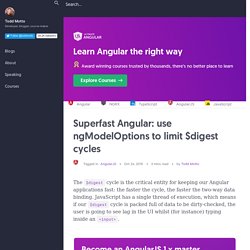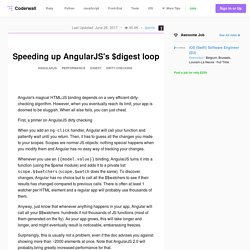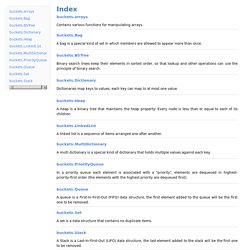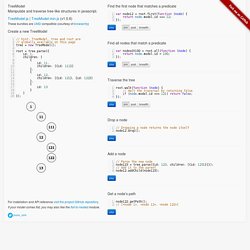

Do you really know what unidirectional data flow means in Angular. Superfast Angular: use ngModelOptions to limit $digest cycles. The $digest cycle is the critical entity for keeping our Angular applications fast: the faster the cycle, the faster the two-way data binding.

JavaScript has a single thread of execution, which means if our $digest cycle is packed full of data to be dirty-checked, the user is going to see lag in the UI whilst (for instance) typing inside an <input>. 0days 02hours 34mins 39secs $digest cycles run from internal Angular events (yes and $scope. Problem The problem with dirty-checking is that larger $digest loops will take longer to complete, which means the user could see some lag whilst using the application. For this article, I’ve written a tiny Directive that logs our $digest cycle counts, so we can actually see the impact that simple UI interactions may have on our applications. Let’s take a simple <input> for this example with ng-model bound to it: The live output: Type away, you’ll see the $digest count rockets into double and triple figures.
Solution. The Top 5 Mistakes AngularJS Developers Make Part 4: Hacking the DOM. This is the fourth part in a five-part series that covers common AngularJS mistakes.

To recap, the top five mistakes I see people make are: In the previous posts I’ve covered some nuances around controllers and how they communicate with each other and expose information for data-binding. In this post I’ll elaborate on the importance of data-binding and share why it’s important to avoid hacking the DOM when writing an Angular application. In the end, web applications are about the DOM. You may be surprised to learn one of the most viewed posts of all time on this blog is a short one about a simple hack for IE 6.0 that I posted almost five years ago.
In fact, shortly after that post I did a proof of concept for an emerging technology (at the time) called Silverlight and ended up converting to it. Speeding up AngularJS's $digest loop (Example) Angular's magical HTML/JS binding depends on a very efficient dirty-checking algorithm.

However, when you eventually reach its limit, your app is doomed to be sluggish. When all else fails, you can just cheat. First, a primer on AngularJS dirty checking When you add an ng-click handler, Angular will call your function and patiently wait until you return. Then, it has to guess all the changes you made to your scopes. AngularJS : How to watch service variables? Angularjs - angular JS - communicate between non-dependend services. Speeding up AngularJS's $digest loop (Example) Is it a bad practice to always use $broadcast/$on on the $rootScope in AngularJS? We use lots of services that fire events on the $rootScope so controllers/other services can listen to them with $rootScope.$on(), but is this the right way to do it?
Sharing Data in AngularJS: Be Aware of $watch. This AngularJS tutorial is about concise and precise communication of shared state updates from AngularJS services to AngularJS controllers.

It warns about race conditions upon AngularJS application bootstrap, and points out advantages of $broadcast over $watch. The topics discussed in this article are supported by minimal working code examples. Finally, this article provides code that can hopefully serve as a best-practice snippet for your own application. The article was originally posted at Jan-Phillip Gehrcke’s blog. Note: this article has been written with AngularJS version 1.3.X in mind. Introduction to the problem I have worked with AngularJS for a couple of days now, designing an application that needs to interact with a web service.
How should I handle the automatic initial retrieval of remote data upon application startup? JsDoc Reference - Index. Buckets.Bag A bag is a special kind of set in which members are allowed to appear more than once. buckets.BSTree Binary search trees keep their elements in sorted order, so that lookup and other operations can use the principle of binary search. buckets.Dictionary Dictionaries map keys to values, each key can map to at most one value.

TreeModel. TreeModel Manipulate and traverse tree-like structures in javascript.

TreeModel.js | TreeModel-min.js (v1.0.6) These bundles are UMD compatible (courtesy of browserify) Create a new TreeModel. Ускорение приложений Angular с помощью ручной генерации HTML-кода. Angular 2 просто ужасен - TuHub. Ultimate Angular: AngularJS Performance. How to create giant memory leaks in AngularJS - makandra dev.
Posted about 3 years ago.

Visible to the public. Repeats. This guide shows how to create an AngularJS application that consumes more and more memory until, eventually, the browser process crashes on your users. Although this guide has been written for Angular 1 originally, most of the advice is relevant for all client-side JavaScript code. To inspect the amount of memory consumed by your Javascripts in Chrome: Open an incognito window Open the page you want to inspect Press Shift + ESC to see a list of Chrome processes Find the process for the incognito window Right-click on the list and check Javascript memory Observe the Javascript memory column as it grows and grows while using your app Note that you can manually run the Javascript garbage collector: Open the Developer Tools (Ctrl+Shift+J) Open the Timeline tab Click on the garbage can icon.
Transclusion and Template Scope in Angular Directives Demystified. Angular 2+/4/5: Smart, dumb and deeply nested component communication. Passing attributes through multiple components · Issue #136 · toddmotto/angularjs-styleguide. Writing component based app with angular 1.5. The angular team introduced the .component() method in version 1.5, it allows us to write component based apps using angular 1, this approach makes it easier to transfer your code base to angular 2.

In this guide we will build "Goatlove"(Got-love :), which is a dating app, for goats. It will help us to see component based architecture in action, and hopefully, find some goats around the world a true love. You can find the entire code here. Components based architecture The component based architecture is a rising star in the world of web development, with libraries like React, and the new direction Angular 2.0 is headed. Working with components means separating your apps into small chunks, usually just a few lines of code each. Angular 1.X embraced the use of directives, but defining a directive for me was really annoying, all the boilerplate, markup, link functions, transclusion, etc... we're quite intimidating. Egghead. Christianalfoni WebApp Enthusiast. I had a presentation on the history of going from traditional web applications with MVC on the server, moving over to the client with stuffed script tags running Ajax and jQuery code and to the adoption of MVC in the browser environment.

I ended the talk with FLUX concepts and how it helps us handle application state. After almost shitting my pants during my first one hour talk on development I got a lot of good questions on MVC and FLUX. Christianalfoni WebApp Enthusiast. Change detection in Angular versus AngularJS - Code with style! Change detection is the mechanism responsible for data binding in Angular.

Thanks to it you don’t need to manually manipulate the DOM tree. Instead, you can make changes to the model and they are automatically reflected in the view. In this post I’ll try to briefly explain the differences of how change detection works in AngularJS (version 1.x) versus Angular (version 2+). Why should you care about this? It’s generally a good idea to understand how the framework you’re using works under the hood. Scroll to the bottom for a table summarizing major differences. When to detect changes? Let’s think about how the process of change detection could look like in big picture. One-way Data Flow (in AngularJS 1.6) – Building VTS. How to design large AngularJS applications that scale – Sebastian Fröstl and Gernot Höflechner. Очищение почек. Очищение почек - третий этап очищения организма. Почки являются важнейшим органом по поддержанию оптимального состояния внутренней среды организма.
Read Web Component Architecture & Development with AngularJS. Read Web Component Architecture & Development with AngularJS. SOA with Angular by Wesley Cho. Why is frontend web development so difficult? The browser is evolving rapidly ECMAScript 6 Web Components Internet Explorer usage dropping Complexity shifted from backend to frontend.
Considering Speed and Slowness in AngularJS – Ex Ratione. AngularJS is a Javascript framework used as the basis for single-page applications that largely run in the client, usually exchanging information with the server via REST or REST-like APIs. Like most of its sibling frameworks it is fast in modern browsers: this is an age of machines with a great deal of memory and processing power. If you are building an application that never displays more than a modest amount of data to the user all at once, and will not be used on mobile devices or tablets, then you rarely have to pay all that much attention to performance on the client. To a first approximation everything just works and just works fast enough for the matter at hand.
The Basics: What Chews Up Time Under the hood only a few line items are important from a speed point of view in the average AngularJS application: Scalable Single-Page Application Architecture · Minko Gechev's blog. In order to have better understanding of the following blog post you should be familiar with the fundamentals of the object-oriented and functional programming.
I also strongly encourage you to explore the redux pattern. A couple of months ago I started working on the first version of a Silicon Valley-based startup. The project is a single-page application with quite dynamic business requirements. As in most modern single-page applications we have a fat client which encapsulates decent amount of business logic and state. Anatomy of a large Angular application – Kristian Poslek. A question often pops up in this layer — are we going to reach data to a component through isolated scope or get a service injected and request it? The answer to that question is not always clear and involves using common sense.Smaller, reusable components without child components are a clear candidate for getting data through isolated scope and directly using that data.Components featuring child components or more logic often benefit much more from getting their data through an injected service because they don’t get coupled to their parent.
Facade layer The facade layer is an abstraction layer. Tuning Angular's Change Detection. Wanna keep up to date with the latest webdev stuff? Follow me on Twitter My friend Todd knows how to create top-notch video courses. Performance Improvements and Fixing Memory Leaks within an AngularJS Application. Introduction. Performance Improvements and Fixing Memory Leaks within an AngularJS Application. Web Workers with AngularJS. Web Workers provide a means for processing data in background threads. Processing that occurs off the main thread is useful because JavaScript code executes in turns on a single thread. In the context of a web browser, while a turn is executing, no other processing occurs, and, if a turn runs long enough, the browser’s interface will be perceptibly frozen. Optimizing AngularJS: 1200ms to 35ms - Scalyr Blog.
Edit: Due to the level of interest, we’ve released the source code to the work described here: Here at Scalyr, we recently embarked on a full rewrite of our web client. ABE Part 4 — Consuming APIs and sharing data with AngularJS services. The fourth part in the AngularJS by Example series showing how to use AngularJS services to consume a third-party API and share data throughout your entire application, while providing best practice & implementation examples. View the demo or take a look at the code.
AngularJs cross components communication. Bilal 16.Mar.2015 8 comments In this article we will discuss different techniques for communicating across different components in angular i.e directives, controllers. It’s a common problem that you need some type of communication between different controllers so that you can use some functionalities offered by one controller in another controller. Today we will look at this problem. Angular Directives Componentization and Composition. Speeding up AngularJS apps with simple optimizations. AngularJS is a huge framework with that already has many performance enhancements built in, but they can’t solve all our problems.
No matter how fast the framework, we can all create sluggish code through bad practices and not understanding key concepts that help it perform well. Watch how the apply runs a digest. UPDATE: This post is meant for beginners, for those that just started to learn Angular and want to know how data-binding works. If you already know how to use Angular properly, I highly suggest you go to the source code instead. Effective Strategies for Avoiding Watches in AngularJS.
AngularJS Tutorial - Understanding $apply and $digest (in depth) AngularJS - Understanding digest cycle (digest phase or digest process or digest loop) AngularJS - Understanding Watcher, $watch, $watchGroup, $watchCollection, ng-change. AngularJS' Internals In Depth. AngularJS migration — use redux to nuke $scope soup. Boost the Performance of an AngularJS Application Using Immutable Data. Tuning AngularJS for Performance. 5 Guidelines For Avoiding Scope Soup in Angular - Techno Fattie. Optimizing code using Object.defineProperty. Top 18 Most Common AngularJS Mistakes That Developers Make. $watch how the $apply runs a $digest. Angular JS - you probably shouldn't use $watch in your controllers. The Three Watch Depths of AngularJS. The Three Watch Depths of AngularJS. How do I use $scope.$watch and $scope.$apply in AngularJS? How do I use $scope.$watch and $scope.$apply in AngularJS? How do I use $scope.$watch and $scope.$apply in AngularJS? Mastering $watch in AngularJS. AngularJS : How to watch service variables?
ПРАКТИЧЕСКИЕ ОПЫТЫ ПО СОЗДАНИЮ АНТИГРАВИТАЦИОННЫХ СТРУКТУР. Lifecycle hooks in Angular 1.5. Component-based application architecture with AngularJS and Typescript - Ryan de Gruyter — Ordina JWorks Tech Blog. An example converting angular 1.5 to use RxJS. Underscore: Ещё больше функциональщины в JavaScript! Оптимизация JS с помощью функционального подхода. Pattern Matching in ECMAScript. Реактивные интерфейсы на ванильном JavaScript — Часть 1: Чистый функциональный стиль. Lifecycle hooks in Angular 1.5. Angular-structure-styleguide/README.md at master · kevinvanhove/angular-structure-styleguide. Angular >=1.5 Component Communication.
Angular 1.5 app as a tree of components [“NG 1.5 from the trenches” 2/7] – velesin.io. Component communication on AngularJS1.5 - Plunker. Communication between Angular 1.5 components (and with the API) [“NG 1.5 from the trenches” 3/7] – velesin.io. Angular >=1.5 Component Communication. Angularjs and Requirejs for very large applications - Coding Experience. Osx - Javascript on Mac (Safari) toLocaleTimeString() oddities. Webdesign.tutsplus. Problems with Safari and innerHTML. SetInterval not working in iOS 8 – Home Screen Apps Lose Timing Functions After Lock/Wake – Carra Lucia Ltd. SetTimeout doesn't work on iPad using Safari. JavaScript setTimeout delay ignored on IPhone.